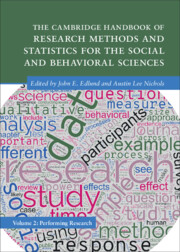 The Cambridge Handbook of Research Methods and Statistics for the Social and Behavioral Sciences
The Cambridge Handbook of Research Methods and Statistics for the Social and Behavioral Sciences Book contents
- The Cambridge Handbook of Research Methods and Statistics for the Social and Behavioral Sciences
- Cambridge Handbooks in Psychology
- The Cambridge Handbook of Research Methods and Statistics for the Social and Behavioral Sciences
- Copyright page
- Dedication
- Contents
- Figures
- Tables
- Contributors
- Preface
- Part I Quantitative Data Collection Sources
- 1 Student Samples in Research
- 2 Mechanical Turk: A Versatile Tool in the Behavioral Scientist’s Toolkit
- 3 Social Media Research
- 4 Prolific: Crowdsourcing Academic Online Research
- 5 Field Research
- 6 Organizational Research
- 7 Integrating Culture in Research
- 8 Mixed Methods and Multimethod Research
- Part II Important Methodological Considerations
- Part III Self-Report Measures
- Part IV Behavioral Measures
- Part V Physiological Measures
- Part VI Qualitative Data Collection Sources
- Index
- References
5 - Field Research
from Part I - Quantitative Data Collection Sources
Published online by Cambridge University Press: 12 December 2024
- The Cambridge Handbook of Research Methods and Statistics for the Social and Behavioral Sciences
- Cambridge Handbooks in Psychology
- The Cambridge Handbook of Research Methods and Statistics for the Social and Behavioral Sciences
- Copyright page
- Dedication
- Contents
- Figures
- Tables
- Contributors
- Preface
- Part I Quantitative Data Collection Sources
- 1 Student Samples in Research
- 2 Mechanical Turk: A Versatile Tool in the Behavioral Scientist’s Toolkit
- 3 Social Media Research
- 4 Prolific: Crowdsourcing Academic Online Research
- 5 Field Research
- 6 Organizational Research
- 7 Integrating Culture in Research
- 8 Mixed Methods and Multimethod Research
- Part II Important Methodological Considerations
- Part III Self-Report Measures
- Part IV Behavioral Measures
- Part V Physiological Measures
- Part VI Qualitative Data Collection Sources
- Index
- References
Summary
Field research refers to research conducted with high degrees of naturalism. Compared with other research methodologies, field research can preserve the rigor of traditional laboratory research while augmenting the ecological validity and social impact of the research findings. The first part of this chapter provides a definition of field research and discusses its advantages and challenges. The second part of the chapter provides a brief overview of qualitative field methods and an in-depth overview of experimental field methods. It discusses different types of randomization schemes in field experiments, such as cluster randomization, block randomization, and waitlist designs. It further discusses the design and implementation concerns when conducting field experiments, including spillover, attrition, and non-compliance. The third part of the chapter provides an overview of some important considerations for conducting field research, including pilot testing, replicability and generalizability across contexts, and how geographical and technological advances impact field research.
- Type
- Chapter
- Information
- The Cambridge Handbook of Research Methods and Statistics for the Social and Behavioral SciencesVolume 2: Performing Research, pp. 93 - 115Publisher: Cambridge University PressPrint publication year: 2024
